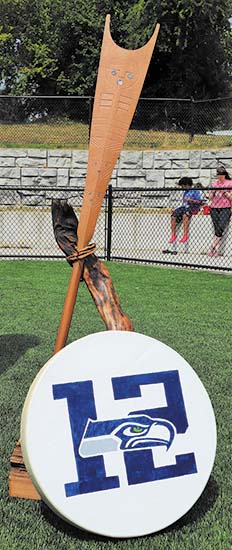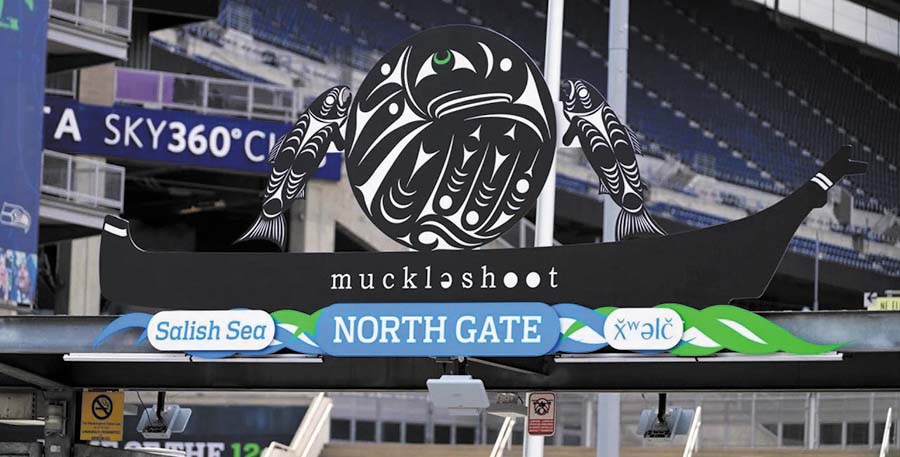
By Micheal Rios, Tulalip News
There is no such thing as a seahawk. This may come as a surprise to some Seattle football fans who, while tuned into this weekend’s 2021 NFL Kickoff, may be unaware of the origin of their home team’s logo. Some might even assume that, as an appropriated Indigenous design, it falls under the banner of problematic logos, like those of a handful of other sports franchises, such as the Cleveland Indians or the Kansas City Chiefs.
But unlike those teams, whose logos are founded on stereotypes (as opposed to any specific aspect of one of Native America’s 574 federally recognized tribes) the Seattle Seahawks’ logo is that rarest of birds: a culturally accurate sports icon directly inspired from an Indigenous masterpiece — and embraced by the Indigenous People it is borrowed from.
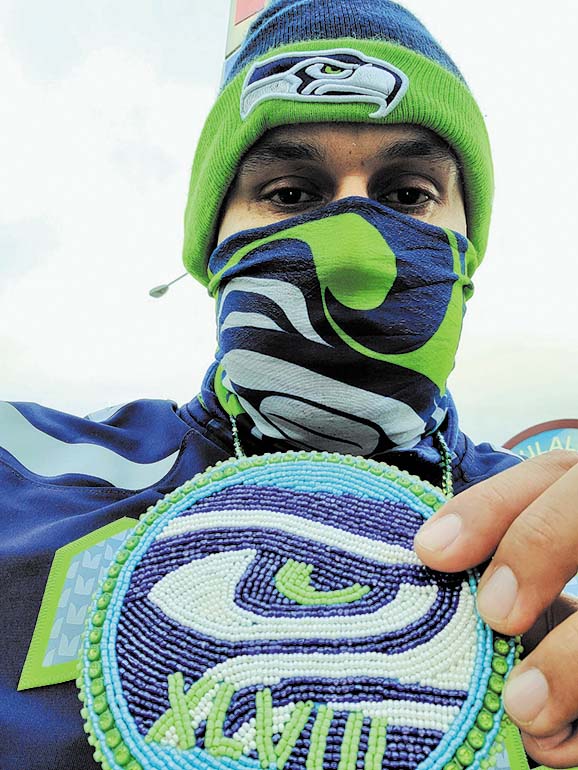
Anatomy of a logo
Ornithology experts theorize the term seahawk refers to a combination of an osprey, which is a bird of prey native to coastal North America, and a skua, which, in the Pacific Northwest, we normally call a seagull. So if there isn’t an actual “seahawk” found in nature, then where did the inspiration for the Seattle Seahawks’ logo come from?
The general consensus is that in 1976 the NFL commissioned a logo for the newly formed Seattle football team. Then-General Manager Ted Thompson wanted the Seahawks’ logo to reflect “Northwest Indian culture.” He and his team of concept designers must have been Native culture enthusiasts who stumbled across a truly remarkable piece of Indigenous Northwest Coastal art. That artwork in question was a Kwakwaka’wakw (pronounced: KWA-kwuh-kyuh-wakw), a transformation mask from northeastern Vancouver Island.
In September 2014, the Burke Museum, located on the University of Washington campus, learned of the mask’s whereabouts and launched an online fundraising campaign to bring it back to the Northwest Coast. It didn’t take long to raise the money needed to conserve, insure and ship the mask across the country. Within weeks of arrival the hidden history of the mask was unveiled and the origin story of the Seahawks logo went public.
While the details behind the origin story of the Seahawks’ logo remained a mystery for decades, what has always been certain is its positive celebration by local Coast Salish tribes. All along the Salish Sea, tribal people have embraced the Seahawks logo and re-appropriated it into our culture.
“Great things inspire imitations. In the same way that so many Native people and white people and Asians are inspired by hip-hop, an art form created by Black people, many people are inspired by our beautiful art,” said attorney and Seattle resident Gyasi Ross (Blackfeet). “Native people have some beautiful artwork, and of course it inspires people to want a piece of it. The Seahawks logo is a perfect example of that. And we love it.
“But also, the Seahawks are actually active and respectful of the huge Native community here in the Pacific Northwest,” he added. “From speaking at graduations to speaking out against the [Washington] Redskins mascot, the Seahawks have a great relationship with the Native community here, both urban and Reservation-based.”
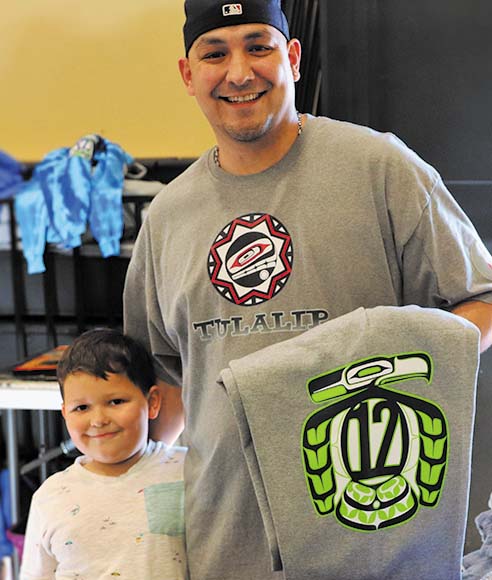
A team that uplifts
Their commitment to Native communities is what distinguishes the Seahawks from so many other organizations that claim to honor Native culture with their logos and mascots, yet contribute little or nothing to their local tribes. The Seahawks have a history of making significant impact to the Tulalip Tribes in particular.
Back in 2008, Seahawk Bobby Engram collaborated with Home Depot, the Kaboom! Program, and Boys & Girls Clubs of Snohomish County to build a 50-by-50-foot playground at the reservation’s ‘Club.’ In 2014, following a shooting at the Marysville-Pilchuck High School, the Seahawks hosted tribal member Nate Hatch, who was shot and survived, along with his family at CenturyLink Field (now Lumen Field), where they received the VIP treatment from players and coaching staff.
Then in June 2019, Seattle Seahawks legend Michael Bennett hosted a once-in-a-lifetime football camp for Tulalip community youth. Nearly 250 participants ages 7 to 18 had an opportunity to catch a pass from and do drills with the Super Bowl champion. Afterwards, Bennett stuck around to sign autographs and take photos with every single one of his adoring fans. Most recently, in October 2019, former Seahawks Cooper Helfet and Jermaine Kearse landed a seaplane right in Tulalip Bay before spending an afternoon with 30 Tulalip youth.
A history of positive impact. Countless moments to uplift Tulalip youth and inspire them to always dream big. Promoting healthy lifestyle choices and physical fitness as a means of self-discipline to achieve long-term goals. The reciprocal nature of Seahawk respect and appreciation for local tribes and the proud Native fandom they’ve received in return continues to manifest itself in truly imaginative ways.
For starters, it’s common to see the Seahawks’ logo reimagined via Coast Salish designs in all possible mediums. Native artisans have reproduced it as blankets, clothing, beaded jewelry, eye-capturing medallions, wooden panels, furniture, flags, face masks and even six-foot-tall chainsaw carvings that celebrate the Seahawks’ Native roots. These items and more can routinely be found at powwows, all-Native basketball tournaments and other Native vendor-friendly events around the region.
“The Seahawks have given back to our community in so many ways and really made a difference in the lives of our youth,” shared lifelong fan and Tulalip tribal member Josh Fryberg, whose family of eight buys new Seahawks jerseys representing their favorite players every year. “As for the connection between the Seahawks and Coast Salish art, the roots definitely run deep. For my family, we have a lot of Seahawks-themed artwork created by very talented Native artists, both from Tulalip and other tribes. More than the art though, the Seahawks mean family togetherness. Every Blue Friday we rock our jerseys and every game day we gather as a family to cheer on our Seahawks.”
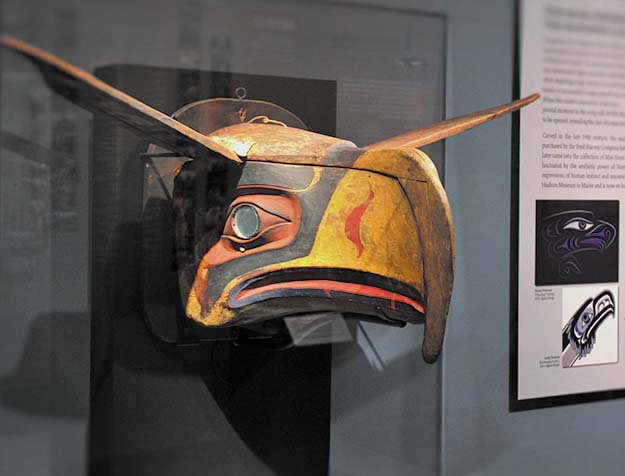
The unique partnership between the Seahawks organization and Coast Salish tribes who comprise part of the devout 12th Man fan base takes on a new, awe-inspiring form outside of Lumen Field. Dubbed “Muckleshoot Plaza”, the field’s north entrances have been adorned by Indigenous artwork. Featuring a massive seahawk, two salmon, a traditional dugout canoe and written Lushootseed, the impossible to miss architecture designed by Muckleshoot artists serve to remind all who pass by that they are guests on Coast Salish land.
“This artwork will not only inspire our communities, but also educate them on the important history of the Native Americans in this region,” said Chuck Arnold, President of the Seattle Seahawks. “We look forward to a long and meaningful partnership for many years to come.”
Whether the Seattle Seahawks make it to this year’s Super Bowl or not, in the hearts and minds of thousands of Coast Salish tribal members, they will always be champions. Not because of a Vince Lombardi Trophy, but because our football team respects their local Native communities off the field — where it matters most.
